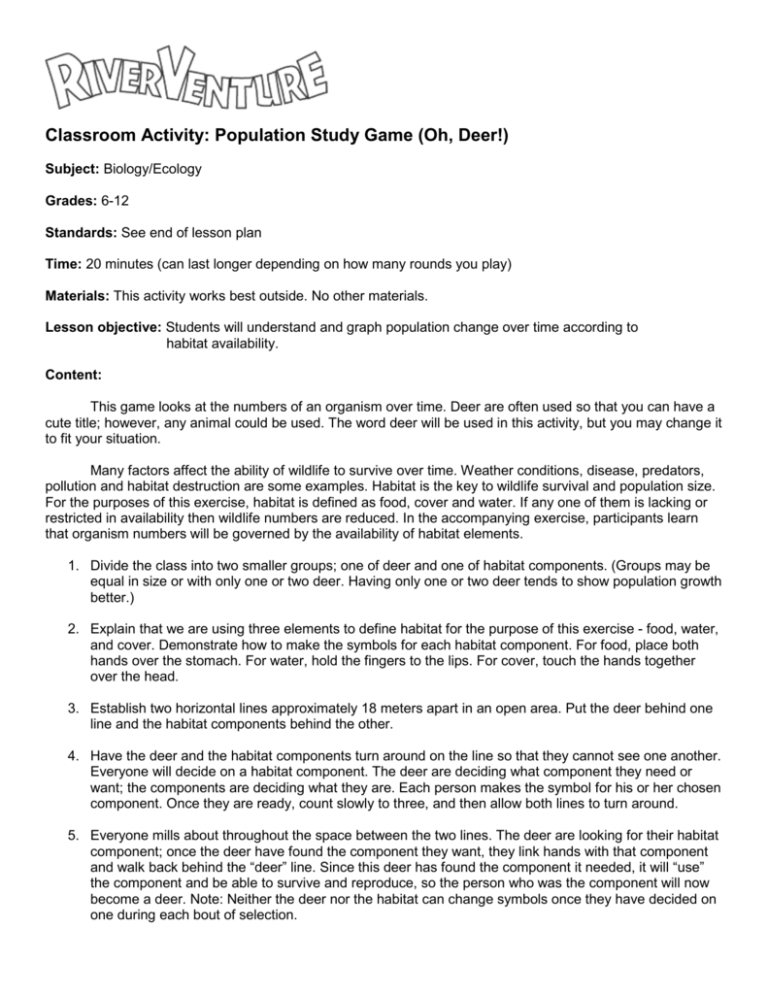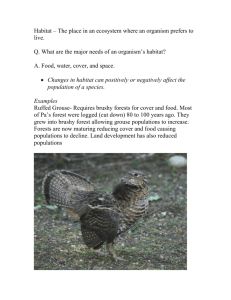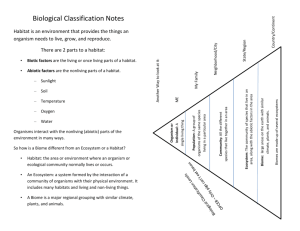Classroom Activity: Population Study Game (Oh, Deer!)
advertisement

Classroom Activity: Population Study Game (Oh, Deer!) Subject: Biology/Ecology Grades: 6-12 Standards: See end of lesson plan Time: 20 minutes (can last longer depending on how many rounds you play) Materials: This activity works best outside. No other materials. Lesson objective: Students will understand and graph population change over time according to habitat availability. Content: This game looks at the numbers of an organism over time. Deer are often used so that you can have a cute title; however, any animal could be used. The word deer will be used in this activity, but you may change it to fit your situation. Many factors affect the ability of wildlife to survive over time. Weather conditions, disease, predators, pollution and habitat destruction are some examples. Habitat is the key to wildlife survival and population size. For the purposes of this exercise, habitat is defined as food, cover and water. If any one of them is lacking or restricted in availability then wildlife numbers are reduced. In the accompanying exercise, participants learn that organism numbers will be governed by the availability of habitat elements. 1. Divide the class into two smaller groups; one of deer and one of habitat components. (Groups may be equal in size or with only one or two deer. Having only one or two deer tends to show population growth better.) 2. Explain that we are using three elements to define habitat for the purpose of this exercise - food, water, and cover. Demonstrate how to make the symbols for each habitat component. For food, place both hands over the stomach. For water, hold the fingers to the lips. For cover, touch the hands together over the head. 3. Establish two horizontal lines approximately 18 meters apart in an open area. Put the deer behind one line and the habitat components behind the other. 4. Have the deer and the habitat components turn around on the line so that they cannot see one another. Everyone will decide on a habitat component. The deer are deciding what component they need or want; the components are deciding what they are. Each person makes the symbol for his or her chosen component. Once they are ready, count slowly to three, and then allow both lines to turn around. 5. Everyone mills about throughout the space between the two lines. The deer are looking for their habitat component; once the deer have found the component they want, they link hands with that component and walk back behind the “deer” line. Since this deer has found the component it needed, it will “use” the component and be able to survive and reproduce, so the person who was the component will now become a deer. Note: Neither the deer nor the habitat can change symbols once they have decided on one during each bout of selection. 6. Any deer that fails to find the habitat element they needed “dies” and will become a habitat symbol. (Once the deer dies, its nutrients will nourish the grass, which would be eaten by the deer; therefore, a dead deer is kind of a part of the habitat.) The habitat person can only satisfy one deer, so if two or more deer try to get the same one, only the first one to reach the habitat person survives. 7. Starting with number 4, repeat the process as many times as you’d like with the new assignments. 8. The leader should record the number of deer at the beginning and end of each bout or round. Running about 10-15 rounds of selection is usually adequate to let participants see how population and habitat quality interact. At the end of the game, plot the deer numbers against “years” (bouts). Discuss axes labels so that students will make sure to graph appropriately. Note the change in behavior of the deer as well. As the habitat becomes more limiting, the deer will run or compete to get the needed habitat first. The leader could also record the numbers of habitats and graph those results. 9. Lead a discussion with the participants on what they observed and did during the game. They should be able to discuss what animals need to survive and how these elements work as limiting factors that affect the animal’s survival. They should recognize that the habitat and the population are both dynamic. Finally, they should be able to recognize the increasing competition by the deer and the stress that places on them. 10. If desired, run a few bouts with “trucks” or “hunters” as mortality factors, where any deer taken becomes habitat. Discuss how that changes the dynamics of the process and the relative pros and cons of each type of population reduction. A volunteer with arms extended moving across the flow of traffic makes a good “truck.” Hunters can “shoot” deer by tossing beanbags or knotted socks filled with a small amount of flour. Limits to hunting could be applied if desired. Leader could also make natural disasters occur and determine who/what is still there. Use your imagination in applying this game to the hunting and wildlife management context. It has many opportunities. Closure: Review/graph the activity with students and have students return to their seats. Students could complete the worksheet found below. Assessment: Students could be assessed on participation. They could also be assessed using the worksheet below that goes along with this activity. This game was adapted from “Oh, Deer,” a Project WILD activity. Project WILD is a national environmental education program developed by the Western Regional Environmental Education Council. Name _____________________________________ Date _______________________ Class _________ I. Graph the results from your population study. (20 points correct x axis. 20 points correct y axis. 20 points correct graph) II. Answer the following questions about the activity. a. What three habitat requirements were in the activity? (8 points for each one) ___________________ _______________________________________________________________________________________ b. How did the organisms act when their habitat requirements became limited? (8 points)_________ _______________________________________________________________________________________ c. Describe how populations of organisms change over time with respect to habitat availability? (8 points) _______________________________________________________________________________________ _______________________________________________________________________________________ Teacher Copy Name _____________________________________ Date _______________________ Class ___________ III. Graph the results from your population study. (20 points correct x axis. 20 points correct y axis. 20 points correct graph) Depends on what you graph, but most likely time in years on the x axis and number of deer on the y axis. The graph should look like a wave. IV. Answer the following questions about the activity. a. What three habitat requirements were in the activity? (8 points for each one) ___________________ _________________________ food, water, shelter _____________________________________________ b. How did the organisms act when their habitat requirements became limited? (8 points)_________ _______________ they competed harder, they were stressed, they fought for the requirements ___________ c. Describe how populations of organisms change over time with respect to habitat availability? (8 points) _________ Population numbers will rise as long as they have enough habitat requirements. When habitat requirements run out, population goes down. It is a continuous cycle of raising and lowering numbers. _______ Standards addressed in this activity: 7.II. Life Science B. Regulation and Behavior 1. All organisms must be able to obtain and use resources, grow, reproduce, and maintain stable internal conditions while living in a constantly changing external environment. a. Analyze the basic characteristics and needs of living things. b. Compare and contrast how organisms use resources, grow, reproduce, and maintain stable internal conditions (homeostasis). D. Populations and Ecosystems 1. A population consists of all individuals of a species that occur together at a given place and time. All populations living together and the physical factors with which they interact compose an ecosystem. a. Describe the characteristics of populations. [The asterisk indicates that this concept has been taught at a previous grade level.] 2. Populations of organisms can be categorized by the function they serve in an ecosystem. All animals, including humans, are consumers, which obtain food by eating other organisms. Decomposers, primarily bacteria and fungi, are consumers that use waste materials and dead organisms for food. Food webs identify the relationships among producers, consumers, and decomposers in an ecosystem. a. Analyze the roles of producers, consumers and decomposers in an ecosystem. b. Identify kinds of relationships organisms have with each other (predator/prey, competition). c. Analyze energy flow in a food chain and its relationship to a food web. 3. The number of organisms an ecosystem can support depends on the biotic resources available. Given adequate biotic resources and no disease or predators, populations (including humans) increase at rapid rates. Lack of resources and other factors, such as predation and climate, limit the growth of populations in specific niches in the ecosystem. a. Compare and contrast how cooperation and predation affect population growth. b. Analyze the effects of overpopulation within an ecosystem on the amount of resources available. c. Analyze how natural hazards (earthquakes, landslides, wildfires, volcanic eruptions, flood, and storms) affect populations. 7.III. Earth Science A. Structure of the Earth System 7. The number of organisms an ecosystem can support depends on the abiotic resources available. Given adequate abiotic resources and no disease or predators, populations (including humans) increase at a rapid rate. Lack of resources and other factors, such as predation and climate, limit the growth of populations in specific niches in the ecosystem. d. Examine how materials are reused in a continuous cycle in ecosystems. 8.II. Life Science A. Diversity and Adaptations of Organisms 3.Extinction of a species occurs when the environment changes and the adaptive characteristics of a species are insufficient to allow its survival. a. Determine the factors that contribute to an organism becoming extinct. b. Explain some of the natural and human-made pressures that can cause extinction. c. Examine ways to prevent the extinction of an organism.








